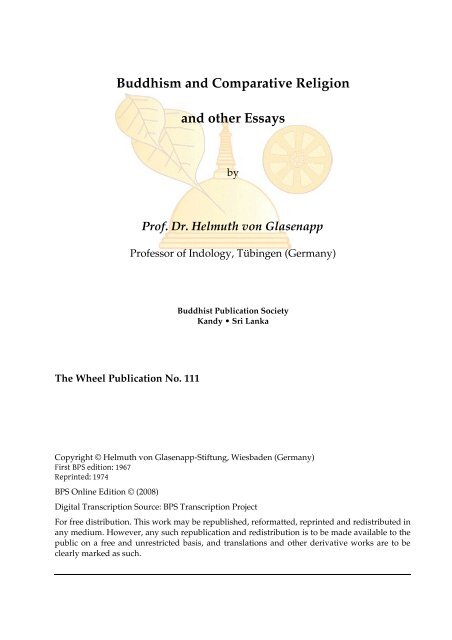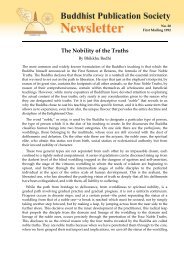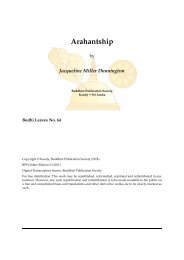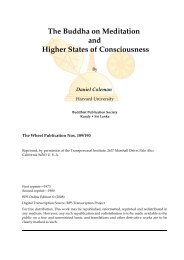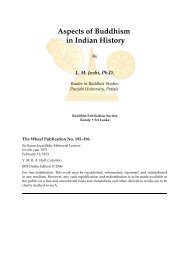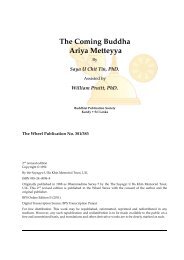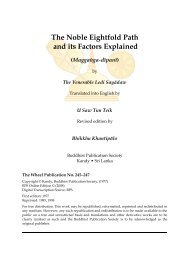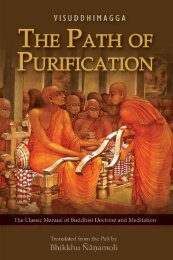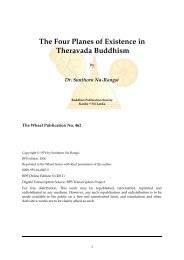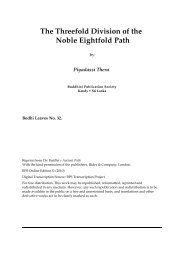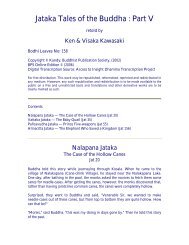Buddhism and Comparative Religion and Other Essays - Buddhist ...
Buddhism and Comparative Religion and Other Essays - Buddhist ...
Buddhism and Comparative Religion and Other Essays - Buddhist ...
You also want an ePaper? Increase the reach of your titles
YUMPU automatically turns print PDFs into web optimized ePapers that Google loves.
Contents<strong>Buddhism</strong> <strong>and</strong> <strong>Comparative</strong> <strong>Religion</strong>....................................................................................................3The Influence of <strong>Buddhist</strong> Philosophy...................................................................................................7The Buddha’s Place in Indian Thought................................................................................................122
emerges from it, just as the fire of the second part of the night is the uninterrupted continuationof the fire that burnt during the first part of it. It is not our task here to deal with the differenttheories of the antarābhava, 2 etc. which have been devised to explain or to prove this theory. Inthis connection it is sufficient for our purpose to establish the fact that <strong>Buddhism</strong> is in fullaccordance with many other religions in the supposition of a life after death in which all acts arerequited. The only difference between <strong>Buddhism</strong> <strong>and</strong> other Indian religions consists in this that<strong>Buddhism</strong> gives a different philosophical interpretation. In practice it is in complete harmonywith all systems that accept metempsychosis. Instead of the theory of an immutable permanentsoul which forms the nucleus of the individual A in this existence <strong>and</strong> of the individual B in thenext existence, it offers a different view: every individual is a stream of evanescent dharmas(physical <strong>and</strong> mental factors of existence) arising in functional interdependence. Every newindividual existence is the flowing on of this stream.This doctrine of reincarnation without the adoption of the belief in a persistent soul-substancehas always puzzled scholars, <strong>and</strong> it has been called a logical impossibility because it denies theidentity of the man who has done an action <strong>and</strong> of another man on whom it is rewarded. But intruth it has quite the same metaphysical value as the theory of a w<strong>and</strong>ering permanent soul.Professor T. R. V. Murti 3 rightly says: “How does the acceptance of the ātman, the unchangingpermanent entity, explain kamma, rebirth, memory or personal identity more plausibly? As thepermanent soul is of one immutable nature, it cannot have different volitions when differentcircumstances call for different actions. … A changing ātman (soul) is a contradiction in terms.No ātman-view has accepted or can accept a changing self; for once we accept change of theātman, we have no valid argument to confine this change to definite periods i.e. it remainsunchanged for an appreciable stretch of time <strong>and</strong> then changes. This would mean two differentātmans. Nor can we admit that one part of the ātman changes while the other part is permanent.If the changing part does belong to the ātman as integrally as the other part, then we would behaving a supposedly unitary entity, which has two mutually opposed characteristics. This doesviolence to our conception of an entity.”When the Buddha replaced the theory of a permanent soul substance with the theory of a“mind-continuum,” he tried to avoid the difficulties inherent in the doctrine of ātman. That histheory also conceals knotty points is evident. For, no sufficient philosophical arguments can beadduced for things which transcend the human faculty to demonstrate rationally matters thatare not accessible to our limited comprehension. The belief that there is no continuation of anysort of life after the death of an individual is also not strictly demonstrable; for the theory of amatter out of which everything is produced is as equally an outcome of speculation <strong>and</strong> of acertain “Weltanschauung” as the different hypotheses concerning the soul or the mindcontinuum.Stranger still, it appears to most observers that <strong>Buddhism</strong> denies the existence of a creator<strong>and</strong> ruler of the world because for many religious minds, especially in the Occident, religion issynonymous with the belief in God. For this reason many theologians have said, “<strong>Buddhism</strong> is aphilosophical or ethical system but no religion.” This view, however, is a very superficialsubterfuge. For, judging from its outward appearances as well as from its inner attitudes,<strong>Buddhism</strong> exhibits all the marks observed in other religions. It has places of worship, rites, <strong>and</strong>monasteries, <strong>and</strong> with its adherents it calls forth purely religious feelings of devotion, piety,tranquillity of mind, etc. It has its legends, relates wonders, tells of visions of heaven <strong>and</strong> hell,etc. It even acknowledges a great number of celestial beings who, although they have no eternallife, exist for centuries <strong>and</strong> may give their worshippers worldly comfort <strong>and</strong> happiness. All thismakes it evident that to <strong>Buddhism</strong> the appellation religion cannot be denied. This shows that2Intermediate existence between two lives; a conception developed in later schools of <strong>Buddhism</strong>.3T. R. V. Murti, The Central Philosophy of <strong>Buddhism</strong>, London 1955, p. 32.4
The thoughtful reader may ask how it is possible that so many religions dissent from anopinion cherished by so many religious heroes like Moses, Christ, Mohammed or the greatVaishnava <strong>and</strong> Saiva saints. The answer is that the idea of God is a very complex one. Itcombines the ideas of a creator, ruler, <strong>and</strong> destroyer of the universe with those of an author ofmoral laws, of a just judge, of a helper in need <strong>and</strong> a saviour of mankind. In <strong>Buddhism</strong> the sameideas are distributed among several factors. The creation, rule, <strong>and</strong> destruction of the universeare ascribed to the Universal Law as are the allotment of reward <strong>and</strong> punishment according tothe automatically working kamma. As this Law is immanent in the cosmos there is no need of aLawgiver. The revealers of this Law are the Buddhas, who for this reason are venerated. Thetransitory devas (deities) function as helpers in worldly troubles. Concerning the question ofsalvation the <strong>Buddhist</strong> schools differ: for some of them it can be reached only by man’s ownendeavours; for other schools the grace of the Buddha Amitābha is the expedient for salvation.The feelings of devotion <strong>and</strong> reverence, which the theistic religions concentrate upon God, areturned towards the Buddhas as the sages who have shown the way to Nirvāna.So the same ideas, impulses, instincts, longings, <strong>and</strong> hopes which determine the theisticreligions are equally alive in <strong>Buddhism</strong>, <strong>and</strong> they are, above all things, the most essential featureof all religions: the conception of awe-inspiring holiness <strong>and</strong> the sense of the holy which isdifferent from everything profane.6
The Influence of <strong>Buddhist</strong> Philosophy 6On the occasion of the two previous meetings of our Symposium, the Contribution of <strong>Buddhism</strong>to Art <strong>and</strong> Letters was dealt with. We proceed now to our discussion on <strong>Buddhism</strong>’sContribution to Philosophy. Making use of a simile employed by Ān<strong>and</strong>avardhana on poetry Imay say this: Art is the beautiful corporeal frame of <strong>Buddhism</strong>, literature is its prāṇa or lifebreath,philosophy is its mind; so that the topic of our deliberation is, as it were, a task ofpenetrating gradually more <strong>and</strong> more into the depth of the inner core of the great spiritualmovement which has given so much to the world.I feel deeply honoured by having been asked to preside over this session. I take it as adistinction not so much for my own humble endeavours to fathom the profundity of <strong>Buddhist</strong>philosophy but as an award of honour bestowed upon my country, because especially inGermany, philosophers have for a long time shown great interest in <strong>Buddhism</strong>.The first Germans who had heard the name of the Buddha were probably theologians whohad read the works of St. Hieronymus, one of the fathers of the Christian Church. For, this saintmentions the miraculous birth of the Buddha. But of Buddha’s doctrine, nobody seems to havehad any detailed knowledge during the Middle Ages. It was not until the 17 th century that aGerman philosopher obtained some knowledge of <strong>Buddhism</strong>. It was Gottfried Wilhelm Leibniz(1646–1716) who took a very keen interest in China, whose philosophy had just been madeknown to Europe by the works of French Jesuits. Leibniz drew from their books some points ofthe <strong>Buddhist</strong> doctrine as taught in the Chinese Empire. In his most famous book, the Theodiceehe speaks of Fo, as the Chinese call the Buddha, <strong>and</strong> refers to the Madhyamika-System <strong>and</strong> itsdoctrine of Emptiness.A wider range of knowledge we find with Immanuel Kant (1724–1806). It is not much knownthat Kant at the University of Königsberg delivered not only lectures on Philosophy but also onGeography. Without ever having left his native town he had acquired a considerable knowledgeof all the parts of the globe by reading books on travel. He therefore in his lectures speaks about<strong>Buddhism</strong> in Ceylon, Burma, Siam, in China, Japan <strong>and</strong> Tibet. He draws a very sympatheticpicture of the <strong>Buddhist</strong> monks in Burma. He says, “The Talapoins of Pegu are praised as theworld’s kindliest men. They live on the food which they beg at the houses <strong>and</strong> give to the poorwhat they do not need for themselves. They do good to all living beings without making anydiscrimination on the grounds of religion. They think that all religions are good which makemen good <strong>and</strong> amiable.”Kant already knew that <strong>Buddhist</strong>s do not believe in a creator <strong>and</strong> ruler of the universe whojudges men after death, for he writes; “They reject the idea of divine providence, but they teachthat vices are punished <strong>and</strong> virtues are recompensed by a fatal necessity.” Kant did not yetknow anything about the <strong>Buddhist</strong> doctrine of Kamma <strong>and</strong> Rebirth, <strong>and</strong> his philosophy has inno way been influenced by <strong>Buddhist</strong> ideas. But the doctrine of metempsychosis appealed to himin several periods of his life. Even shortly before his death, when asked by his friend Hasseabout the future of the individual after death, Kant expressed himself in favour of the doctrineof transmigration. On another occasion he called it one of the most attractive teachings ofOriental philosophy. He himself taught a pre-existence of the soul before man is born <strong>and</strong> he6Presidential Address delivered at the Fifth Session on “<strong>Buddhism</strong>’s Contribution to Philosophy” of theSymposium on “<strong>Buddhism</strong>’s Contribution to Art, Letters <strong>and</strong> Philosophy” arranged from November 26 thto 29 th , 1956, in New Delhi, by the Working Committee for the 2,500 th Buddha Jayanti, Government ofIndia, in collaboration with the UNESCO, to commemorate the 2,500 th Anniversary of the Parinirvāna ofthe Buddha. Reprinted from The Mahā Bodhi, Vaisakha Number 1957.7
was of opinion that after death man has to continue his way to perfection in infinite progress.His ideas have, therefore, in this point much in common with <strong>Buddhism</strong>.Kant lived at a time when <strong>Buddhist</strong> texts had not yet been studied <strong>and</strong> translated byEuropean scholars. It was only after his death that English <strong>and</strong> French scholars began to occupythemselves with the <strong>Buddhist</strong> scriptures. In contradistinction to Kant, the German philosophersof the beginning of the nineteenth century were better informed about <strong>Buddhist</strong> philosophy.Thus we find with Schelling <strong>and</strong> Hegel some more detailed remarks on <strong>Buddhism</strong>, <strong>and</strong> in latertimes with Nietzsche <strong>and</strong> many other philosophers. An enthusiastic admirer of the greatreligion of the East was Arthur Schopenhauer (1788–1860). Since he was introduced to IndianWisdom as a young man of 26 years of age until his death at the age of 72 he read almost everybook published on <strong>Buddhism</strong> <strong>and</strong> came to the conviction that Buddha, together with Plato <strong>and</strong>Kant, was one of the three great illuminators of the world. He was much influenced by <strong>Buddhist</strong>thought in framing his own system of metaphysics. He believed in a strong conformity of hisdoctrine with that of the Buddha. So he wrote: “If I were to take the results of my philosophy asa yardstick for the truth, I would concede to <strong>Buddhism</strong> the pre-eminence of all religions of theworld. In any case I can be happy to see that my teaching is in such great harmony with areligion which has the greatest number of adherents on earth.” There are, indeed, many pointsin which the German philosopher agrees with <strong>Buddhist</strong>s: they both deny the existence of apersonal God; they teach that neither a beginning nor an end of the cosmic process can beestablished; they both assume the existence of a plurality of world systems; they see no essentialbut only a gradual difference between men <strong>and</strong> animals <strong>and</strong> are therefore ardent advocates ofthe protection of animals against cruelty; they do not believe in permanent immortal souls <strong>and</strong>metempsychosis, but in a rebirth caused by the will (saṃsāra), which manifests itself in thedoings of the previous existence; they both acknowledge a moral law (dharma) as the movingfactor in the universe. Though they both have a pessimistic outlook on life, they are optimistic inso far as they are both convinced of the possibility of a liberation from the trammels of existence.Just as for Buddha, so for Schopenhauer too, the state of deliverance cannot be explained withthe help of terms <strong>and</strong> words belonging to our world of phenomena. Schopenhauer’s system,being an original <strong>and</strong> independent outcome of his own thinking, differs, of course, in manyother points from <strong>Buddhism</strong>. This partly finds its reason in the fact that at the time ofSchopenhauer <strong>Buddhism</strong> was not yet sufficiently known in Europe.Schopenhauer was the greatest herald of <strong>Buddhist</strong> wisdom ever arisen among thephilosophers of the Western world. His works had a deep influence on many other thinkersrendering them in their turn, very keen on studying the sacred writings of the <strong>Buddhist</strong> faith atleast in translation. A remarkable witness of the overwhelming impression that <strong>Buddhism</strong> madeon him are the following words of a great musician, the famous composer, Richard Wagner(1813–1883). He wrote: “Buddha’s teaching is such a gr<strong>and</strong> view of life that every other onemust seem rather small when compared to it. The philosopher with his deepest thoughts, thescientist with his largest results, the artist with his most extravagant imagination, the man withthe most open heart for everything that breathes <strong>and</strong> suffers—they all find their unlimitedabode in this wonderful <strong>and</strong> incomparable conception of the world.”It is an uncontested fact that <strong>Buddhism</strong> has played a role in the realm of Indian philosophyduring the one thous<strong>and</strong> five hundred years of its existence in the sub-continent, not onlybecause it produced a great variety of metaphysical systems many of which belong to the mostelaborate <strong>and</strong> sublime ones the fertile Indian mind has ever created. But the contribution of<strong>Buddhism</strong> is still greater. Through its very existence it has compelled the Brahmanic <strong>and</strong> Jainaphilosophers to defend their teachings <strong>and</strong> to improve <strong>and</strong> remodel them. The discussionskindled by the struggle waged between <strong>Buddhist</strong> philosophy of permanent flux <strong>and</strong> theUpanishadic philosophy of unchangeable being have raised Indian metaphysical thought to that8
high level which has earned for it the admiration of the world. Since the celebrated passage inthe Majjhima Nikāya 22 where Buddha argues controversially against the doctrine of theVedanta, <strong>and</strong> the Kathaka Upanishad 4, 14, where the Brahmins reject the <strong>Buddhist</strong> theories ofdharmas, the antagonism between the Vedanta <strong>and</strong> <strong>Buddhism</strong> permeates the whole history ofIndian philosophy, just as the fight between the conception of the world of Heraclitus <strong>and</strong>Parmenides dominates Greek philosophy. As so often in similar cases, each of the twoopponents has learned much from the other <strong>and</strong> taken over some of the other’s ideas. To mymind the monistic Mahāyāna shows the deep influence which Vedanta has exerted on later<strong>Buddhism</strong>. On the other h<strong>and</strong> the lofty idealism of Yogavasishta of Gaudapada <strong>and</strong> Shankaraare indebted to Nāgarjuna’s <strong>and</strong> Asaṅga’s theories on the unreality of the world.But the contribution of <strong>Buddhism</strong> to philosophical thought is not confined to India.<strong>Buddhism</strong> has been the originator <strong>and</strong> promoter of philosophy in many countries that had notyet developed a philosophy of their own when the doctrine of the Buddha reached them.<strong>Buddhism</strong> has stimulated the intelligentsia in Ceylon, Burma, Siam, Kamboja, Laos, Korea,Japan, Tibet <strong>and</strong> Mongolia, to philosophical endeavours. In China, too, which already possesseda philosophy of a high level, <strong>Buddhism</strong> has greatly developed the indigenous metaphysicalthought. It is well known that Taoism, at least in its later phases, has been influenced by<strong>Buddhist</strong> theories. But Confucianism too is indebted to it. It seems to me that the founder of theNeo-Confucian school, the celebrated Chu Hsi (1130–1200), though a staunch opponent of<strong>Buddhism</strong>, has learned much from <strong>Buddhism</strong>. Idealists such as Shao Yung (1011–1077) <strong>and</strong>Wans Yangmin (1472–1528) too have drawn deeply from the fountain of Mahāyāna.<strong>Buddhism</strong> having had such an enormous direct <strong>and</strong> indirect influence on philosophicalthought in the whole of Southern <strong>and</strong> Eastern Asia proves that it must have appealed greatly toAsian mentality.It is noteworthy, that in contradistinction to the overwhelming importance <strong>Buddhism</strong> has hadin the East, it has till now not been able to fertilize, in a comparable way, thought in the West.The reason for this fact may have been that its sublime doctrines were not easy for Westerners tounderst<strong>and</strong>, though the emperor Ashoka had already sent missions to the Greek kings.As far as our present knowledge goes it was only gradually that <strong>Buddhism</strong> unveiled itsessence to the Occident. The Greeks already knew of the name, Buddha. They also knew of hissupernatural birth <strong>and</strong> they were aware of the fact that the Samanaioi (śrāmaṇa) were differentfrom the brahmanical ascetics. In the Middle Ages the story of Buddha leaving his home wasknown in the Christianized form of the legend of Barlām <strong>and</strong> Josaphat. Marco Polo (1254–1323),the famous Italian traveller, paid his tributes to the saintly life of Gautama when he wrote in hisTravel Diary: “lllec fist moult grans adbstinences, ainsi comme s’il eust este crestien. Car s’il I’eust este,il feust un gr<strong>and</strong> saint avec notre Seigneur Jhesucrist, a la bonne vie et honneste qu’il mena.” “He liveda life of gr<strong>and</strong> abstinence as if he had been a Christian. For had he been, he would have been agreat saint with our Lord Jesus Christ, considering the good <strong>and</strong> honest life he led.” The firstEuropean I know of who mentions an important doctrine of <strong>Buddhism</strong>, which distinguishes itfrom the other great religions of the world was the French traveller, La Loubere, who wrote inhis work Du Royaume de Siam, published in 1691, (Vol. 1, p. 395), “I think that one can establishthat <strong>Buddhist</strong>s do not believe in a world-ruling deity.” We are indebted to the great Englishindologist, Henry Thomas Colebrooke 7 for the first interpretation of the <strong>Buddhist</strong> theory thatthere is no transmigrating soul but nevertheless a rebirth caused by karmic influence. In thelecture “On Indian Sectaries,” read at a public meeting of the Royal Asiatic Society, February 3,1827, he said, “There is not an eternal soul, but merely succession of thought, attended by7H. Th. Colebrooke, <strong>Essays</strong> on the Philosophy of the Hindu (1829). New edition of his works by E. B. Cowell,London 1873, Vol. 11, p. 419.9
undoubted duty of an investigator of the history of Indian thought to show the dependence ofevery new system on older ones preceding it, <strong>and</strong> to trace its very roots to contemporary ideas.Now, there is no possible doubt that the sublime teachings of the Upanishads were in existencebefore Buddha. As Buddha’s Nirvāna in some respect resembles the Brahmā of the Vedanta, itseems plausible to believe that Buddha was a sort of Vedantist. But this, in my opinion, is adelusion. For Buddha’s Nirvāna is in no way like the Brahma, the absolute being, which is thevery foundation of the world, or out of which everything that is has developed <strong>and</strong> come intoexistence. It is only that Nirvāna is a state of peace, of rest, of calm, in which it may be comparedto one of the aspects of the Brahma. But there are many different systems in the world theultimate aim of which is such a state of redemption. But the several systems as such differwidely from Advaita Vedanta because they have a theistic basis, as the Mohammedan <strong>and</strong>Christian mysticism, or as Jainism, which denies the existence of a world-ruling deity. For thisreason the reference to Vedānta carries no weight. One may, of course, argue that a similar need,or requirement, is deeply rooted in many religious minds, but there is neither a necessity nor apossibility to trace all kinds of quietism to the same source.There is yet another deliberation which speaks against the exclusive dependence of Buddha’steachings on that of the Upanishads. The <strong>Buddhism</strong> of the Theravādins <strong>and</strong> all the older schoolsis a pluralistic system. Now a pluralistic interpretation of the world was very common inMagadha, for Jainism was spreading there just at Buddha’s time. As far as I know, nobody hasever tried to deduce Jainism from the Upanishads or to interpret its doctrine in a Vedanticmanner. I cannot therefore see any reasonable ground for assuming that <strong>Buddhism</strong> must havesprung from an Upanishadic fountain. In my work published in 1940 on the stages ofdevelopment of Indian thought, I have tried to trace the <strong>Buddhist</strong>ic dharma-theory toantecedents in the Vedic time; for, the Brahmanas <strong>and</strong> the Vedic texts teach a pluralism ofsubstantial factors which have a strong similarity to <strong>Buddhist</strong> dharmas, for in that remoteperiod of Indian thought qualities such as love, hatred, knowledge etc. were considered assubstances which had their own quasi-independent existence, <strong>and</strong> were not regarded asinherent in any substance. Of course by this I do not mean that the dharmas of <strong>Buddhism</strong> are inany way identical with these archaic concepts of the epoch of the Brahman texts. What I wouldsuggest is only this: that the <strong>Buddhist</strong> theory of dharmas may have arisen out of ideas that havetheir precursors in the Brahmana-time. Between the comparatively primitive <strong>and</strong> crude conceptsof this archaic mode of thinking <strong>and</strong> the highly refined means of the Buddha, there lay centuriesof philosophical development. It may be that between these two periods, other thinkers wereactive in shaping <strong>and</strong> perfecting these ideas, <strong>and</strong> in this respect, the <strong>Buddhist</strong> doctrine that therewere Buddhas before Gautama may not be without foundation.I have tried to show the contribution of <strong>Buddhism</strong> to philosophy. I have tried to show howthe knowledge of <strong>Buddhism</strong> has developed step by step in the realm of the mind of Europeanscholars. I have tried to show some of the problems which European thinkers have tackled, <strong>and</strong>I have taken the liberty of pointing out how I myself st<strong>and</strong> in this respect. Far be it for me tomaintain that the solutions I have tried to offer are in any way definitive; nor do I want to forcethem upon others who many have more knowledge than I have. But perhaps the thoughts Ihave tried to expound here may form a basis for a discussion which may bring to light newfacets of thinking <strong>and</strong> may serve to elucidate some problems of <strong>Buddhist</strong> philosophy.11
The Buddha’s Place in Indian Thought 9The Buddha is the greatest personality that India has produced in the many millennia of herhistory. For the people of Asia’s wide expanses, today as centuries ago, the Buddha is the greatexponent of the spirit of India. His name is known to the uncivilized nomad in the icy steppes ofSiberia as well as to the cultured son of China. To him turn in homage the gentle Sinhalese oftropical Ceylon <strong>and</strong> the war-like Japanese of Nippon’s moderate climes. When early last centuryscholars of the West began to study the spiritual life of Asia, the Sage of the Sakyans, as no othergenius of the East, became the prime focus of interest. No other has been so often mentioned,praised <strong>and</strong> blamed. No other has exercised, even 2500 years after his death, such a significantinfluence on the philosophy of Western thinkers. Among them I mention only Schopenhauer asan example.When searching for the cause of this extraordinary phenomenon, we ask ourselves why justthe Buddha could make such a strong <strong>and</strong> long-lasting impact, while many other Indianthinkers <strong>and</strong> prophets who at their times were equally popular, did not penetrate beyondIndia’s borders <strong>and</strong> were even forgotten in their own home country. In looking for the reasonswe find that in the personality of the Buddha several features are united which only in theirtotality were able to produce that universal effect which the founders of other India religionscould not achieve. The first among the features is the fact that in the course of his preaching theBuddha summarized the results of prior philosophic thought <strong>and</strong> did so in a form that wasprecise <strong>and</strong> yet intelligible to the unlearned; secondly, the fact that the Buddha himself practised<strong>and</strong> embodied up to the highest point the ethical principles which he taught; <strong>and</strong> thirdly, hemade his way of salvation quite independent from the limitations of Indian tradition <strong>and</strong> itscaste system <strong>and</strong> therefore offered it to the whole of humanity.Like all great teachers of mankind, the Buddha was also a child of his time. From hispredecessors he took over the teachings of Kamma, rebirth, the sorrow-yielding transience of allcraving, asceticism, liberation through knowledge <strong>and</strong> Nirvāna. 10 But by giving these teachingsa distinctive philosophical character that took them out of their connection with brahminicaltradition, the Buddha created a teaching of deliverance that was meant for all men. Unlike them,he did not speak of sacrifices or of Brahma, but he may be called a phenomenologist who,restricting himself to the actualities of the inner <strong>and</strong> outer world as perceived by man, explained9Translated from the German, with permission of the publishers, Verlag I. C. B. Mohr (Paul Siebeck),Tübingen (Germany), extracts from Helmuth von Glasenapp, Indisches Leben im W<strong>and</strong>el der Jahrhunderte(Bd. 177, Sammlung gemeinverständl. Vorträge).10Certain doctrines are common features of religious thought because they are truths, or reflections oftruths, similar to the natural laws discovered, often independently, by scientists. Thus it is a fact that somepredecessors of the Buddha had discerned the truths embodied in the teachings of Kamma, rebirth, thesorrow-yielding transience of all craving or rather, of all existence, asceticism, liberation throughknowledge, <strong>and</strong> Nirvāna. But not all the religious teachers of the Buddha’s time accepted them <strong>and</strong> thosewho did so, interpreted them in different ways. It was left for the Buddha to penetrate them further thanhis forerunners had done, <strong>and</strong> to see them in a clearer light, stripped of all adventitious preconceptions.To say that the Buddha ’took over’ those doctrines as Hegel, for example, took over Kant’s doctrine of thecategories, or as Plato took over the central ideas of Socrates, is to place his thought on no more than aprogressive philosophical basis. But in fact the doctrines the Buddha taught were the result of his ownunique, independent confrontation with reality, his own supra-mundane insight (bodhi) carried beyondthe range of intellectual speculation. In some respects, the Buddha confirmed his predecessors’ partialrealizations. In others he corrected them; but his teaching was not in any sense a mere development ofsomething that already existed. It was the vision of one who sees clearly what others had glimpsed witheyes clouded by various forms <strong>and</strong> degrees of ignorance (avijjā). (Editor).12
the nature of suffering, its cause, its cessation, <strong>and</strong> the noble eightfold path leading to Nirvāna.Similarly as his contemporary, Heraclitus of Ephesus, he taught the Panta Rhei, the eternal fluxof all phenomena. The Brahmins taught, as Parmenides did, a state of being, abiding <strong>and</strong>eternal, in which every individual self, has its roots. The Buddha proclaimed the very antithesisof it: there is no abiding Being, no immutable Self; there is only a becoming, a flux. Only byunderst<strong>and</strong>ing the nature not only of the external world but also of the ego is it possible toattain to the highest selflessness that brings about Nirvāna, the dissolution of the imaginarypersonality-complex.The Buddha’s teaching could not have had such an enormous success in India <strong>and</strong> beyond itsborders if not for his so very attractive personality. The Buddha was not a theoretician whooffered good counsel to others, but he was one who by his own example put the final authenticseal on the ethical teachings he proclaimed. Aged 29, he left the luxurious court of his royalfather at Kapilavatthu (in the Himalayas) <strong>and</strong> donned a mendicant’s robe for seeking aftersalvation. In vain he searched for ultimate wisdom among other teachers; in vain he undertookthe severest ascetical self-mortification for many years. Finally, after seven years of spiritualstruggle, the Eye of Underst<strong>and</strong>ing opened within him, under the holy fig tree (the Bodhi Tree),which can still be seen at Bodh Gaya. Thus he became a Holy One, an Awakened One, aBuddha. For over forty years he then walked through the northern parts of India, in ascetic’sgarb, living on collected alms food, <strong>and</strong> preaching his doctrine. Up to his death at eighty, he didnot shirk the hardships of the fatiguing peregrinations on foot, for the sake of spreading hismessage. The texts describe him as a majestic personality, a man of self-abnegation <strong>and</strong> of a rarekindness of heart, the embodiment of passion-free serenity. Pious faith may have later glorifiedthe Buddha surrounding him with a divine aura <strong>and</strong> with a dense overgrowth of legends <strong>and</strong>miracles, but below that sacral over-painting of the original picture there remains the image of aman of rare equipoise <strong>and</strong> serenity; the figure of a Saint who has transcended the world <strong>and</strong>whose features radiate the perfect stillness of his mind.The Buddha was no revolutionary in the Western sense. Though he was opposed to theBrahmins’ arrogance, his aim was not a revolution against the social order as represented by thecaste system in India. A graded structural organization of society appeared to him, thearistocrat, a necessity by natural law, as natural as the gradation of beings in general, startingwith the lowest animals <strong>and</strong> rising, through men <strong>and</strong> spirits, to the gods; because, according tothe Buddha, even gods are subject to Kamma as are men, <strong>and</strong> therefore enjoy their presentposition only for a limited time. What he challenged was the claim of Brahmins to be superior tothe other castes, by virtue of being the guardians of the sacred Vedic tradition. For the Buddha,no class or caste privileges existed as far as salvation was concerned. Hence his emphaticstatement, “Not by birth is one a Brahmin, but only by knowledge <strong>and</strong> moral conduct.” It isonly the moral qualities that determine an individual’s rank in the stages of his gradual progresstowards deliverance. Hence also members of the lower castes were admitted to his monasticOrder. So we find among his disciples, side by side with Brahmins <strong>and</strong> warriors, those who hadbeen scavengers or had other despised occupations, even a converted robber chief. For theBuddha neither noble birth nor wealth was decisive, but solely a man’s underst<strong>and</strong>ing <strong>and</strong> hismoral conduct.The monks <strong>and</strong> nuns who, withdrawn from worldliness, lived, either singly or incommunities, a life of renunciation <strong>and</strong> of active loving-kindness for all that lives, had alwaysbeen only a minority among the Buddha’s followers, as they represented only the upper ranksof his disciples. Below them were numerous lay devotees who, at various stages of dedication<strong>and</strong> inner development, observed only a part of the rules binding on monks; <strong>and</strong> finally therewere the still larger numbers of those who were in sympathy with the teaching <strong>and</strong> participatedin its rites, but who, without exclusive allegiance <strong>and</strong> with the Indian’s typical tolerance, were13
devoted also to other religious cults. Hence, from the <strong>Buddhist</strong> point of view, the teaching ofdeliverance can be understood <strong>and</strong> practised by different people to a very different extent,according to their inclinations <strong>and</strong> capacities. The “road to enlightenment” starts even as fardown as on the level of animals. We hear, for instance, of pious elephants <strong>and</strong> hare, or of a frogthat as reward of homage paid to the Buddha, was reborn in a devout human family <strong>and</strong>,progressing steadily, finally gained deliverance. If one wishes to have a correct idea of the<strong>Buddhist</strong> Weltanschauung <strong>and</strong> outlook on life, one has to familiarize oneself with the <strong>Buddhist</strong>conception that an incalculably large number of living beings, through thous<strong>and</strong>s of years, inthous<strong>and</strong>s of lives, proceed on their way to the light, slowly, though not without relapses. TheWestern concept that salvation depends on the moral quality of one single life must not be usedas a basis for judging <strong>Buddhist</strong> ethics. Hence the widely spread opinion that because theBuddha taught renunciation to his monks, he wanted all men to be monks, is quite erroneous<strong>and</strong> so also the idea derived from it, that <strong>Buddhism</strong> is averse to culture. Because only a fewamong the countless beings will reach Nirvāna after slow progress, therefore <strong>Buddhism</strong>, fromits very start, has provided less stringent ethical precepts for those who only gradually canachieve that maturity required for final liberation. Hence, in <strong>Buddhist</strong> countries, art <strong>and</strong> scienceshave always been cultivated, <strong>and</strong> it is not by chance that <strong>Buddhist</strong>s have been among thefounders of Indian medicine, as it was one of their foremost endeavours to help sufferinghumanity. For the great majority of <strong>Buddhist</strong>s, <strong>and</strong> this I found also in present-day Burma,Siam, China <strong>and</strong> Japan, Nirvāna is only the ultimate, distant goal to which practically only themonk is devoted. <strong>Buddhism</strong> when it flourished, was certainly not a pessimistic <strong>and</strong> life-denyingreligion. This can be seen from the fact that some of the greatest rulers of ancient India, Ashoka(250 B.C.), Kanishka (100 A.C.) <strong>and</strong> Harsha (650 A.C.), were <strong>Buddhist</strong>s.<strong>Buddhism</strong> did not establish in India an organized Church in the Western sense, <strong>and</strong> it had nocentral ecclesiastical authority laying down what was the true faith <strong>and</strong> what was not. Hencethere arose many schools <strong>and</strong> sects who differed from each other in several doctrinal issues,though all of them revered the Buddha as their Master. As enforced conversion is alien to<strong>Buddhism</strong> <strong>and</strong> as it did not dem<strong>and</strong> exclusive allegiance nor a formal repudiation of otherreligions, the total number of <strong>Buddhist</strong>s underwent strong fluctuations. <strong>Buddhism</strong> was neverthe dominant religion of India, <strong>and</strong> it was always only a section of the population that professedit. Even at periods of its widest dissemination on the Indian subcontinent, Brahmanism alwaysremained a strong force. When, since about the 8 th century A.C., Brahmanism came to the foreagain <strong>and</strong> vigorous religious movements arose in its midst to which an ageing <strong>Buddhism</strong> wasno match, Gautama Buddha’s teaching almost vanished in India. Similarly, as Christianitywhich in present-day Palestine counts only very few followers but instead had conquered alarge part of the world, so also <strong>Buddhism</strong> found in the Far East <strong>and</strong> in South-East Asia richcompensation for the loss in India. In Burma, Thail<strong>and</strong>, Cambodia, <strong>and</strong> Laos, in Tibet, Sikkim,<strong>and</strong> Bhutan almost the whole population is <strong>Buddhist</strong>; in Ceylon it is a large majority; <strong>and</strong> inChina, Korea, <strong>and</strong> Vietnam, <strong>Buddhism</strong> has a large number of followers, while in Japan it is thepredominant religion.Within the long history of Indian religion, the one <strong>and</strong> a half millennia of <strong>Buddhist</strong> history onIndian soil are only an episode; but it is an episode of a significance that can hardly be ratedhighly enough. <strong>Buddhism</strong> has amalgamated the currents of Indian thought in a system ofingenious synthesis which decisively influenced minds at a time of India’s political <strong>and</strong> culturalgreatness. It was through <strong>Buddhism</strong> that Indian ideas became known in most parts of Asia, <strong>and</strong>this was an achievement of cultural propag<strong>and</strong>a of a vast extent. But also in contemporaryIndia, the impact of the Buddha, his teaching <strong>and</strong> his community of monks is still very much inevidence. The formulations given by the Buddha <strong>and</strong> his disciples for fundamental concepts ofthe Indian world-view have partly been adapted by the opponents <strong>and</strong> made parts of their14
systems. This applies, for instance, to formulations connected with the law of moral causality(kamma), the teachings on a gradual path to enlightenment, liberation by knowledge, <strong>and</strong>Nirvāna. Also the towering personality of the Buddha could not be overlooked or by-passed:hence they gave to him, the great heterodox, rank of an incarnation (avatār) of God Vishnu.15
The <strong>Buddhist</strong> Publication SocietyThe BPS is an approved charity dedicated to making known the Teaching of the Buddha, whichhas a vital message for all people.Founded in 1958, the BPS has published a wide variety of books <strong>and</strong> booklets covering a greatrange of topics. Its publications include accurate annotated translations of the Buddha'sdiscourses, st<strong>and</strong>ard reference works, as well as original contemporary expositions of <strong>Buddhist</strong>thought <strong>and</strong> practice. These works present <strong>Buddhism</strong> as it truly is—a dynamic force which hasinfluenced receptive minds for the past 2500 years <strong>and</strong> is still as relevant today as it was when itfirst arose.For more information about the BPS <strong>and</strong> our publications, please visit our website, or contact:The Administrative Secretary<strong>Buddhist</strong> Publication SocietyP.O. Box 6154 Sangharaja MawathaK<strong>and</strong>y, Sri LankaE-mail: bps@bps.lkWeb site: http://www.bps.lkTel: 0094 81 223 7283Fax: 0094 81 222 3679


